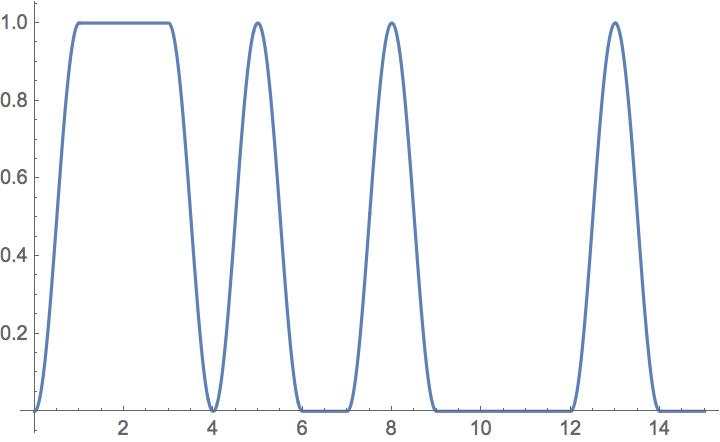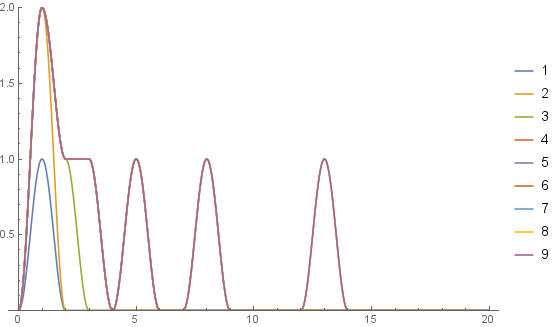I have edited this to include integration:
This is a more general case of this question.
I want to create a function that gives the integral of a series of single pulses of the form Cos[Pi*(x/2)]^2 for all values of x that satisfy some Boolean test.
For example, say I wanted to create a curve that summed pulses for all instances of x on the Fibonacci sequence. Manually, I would do something like
Plot[{With[{n = 1}, Cos[Pi*(Clip[x - n]/2)]^2] +
With[{n = 2}, Cos[Pi*(Clip[x - n]/2)]^2] +
With[{n = 3}, Cos[Pi*(Clip[x - n]/2)]^2] +
With[{n = 5}, Cos[Pi*(Clip[x - n]/2)]^2] +
With[{n = 8}, Cos[Pi*(Clip[x - n]/2)]^2] +
With[{n = 13}, Cos[Pi*(Clip[x - n]/2)]^2]}, {x, 0, 15}]
Integrating (how?) would create a continuous curve.
That's just an example. I want a function in the form Integral[booleantest*pulse,x] that gives the cumulative area under a series of this style of pulse, where each pulse is centred on any Boolean test on integer values of x.
So it seems to me that my question has three parts:
How do I create a function
pulsethat gives this pulse-form for all integerx? Clearly usingWith[{n=...,]isn't going to work. It requires me to manually specify all instances ofpulse.In principle, it's easy enough to create a Boolean test:
booleantest=Boole[EvenQ[x/3]],booleantest=Boole[PrimeQ[x]], etc.So, how do I multiply the two together?
booleantest*pulseshould yieldpulsefor all instances ofbooleantest=1, and0else. But it doesn't work. For example:pulse = Cos[Pi*(Clip[x - n]/2)]^2;booleantest = Boole[EvenQ[n/3]];Plot[pulse*booleantest, {n, 0, 15}]
- How do I create the integral?
I'm clearly doing lots of things wrong... So, sticking to the idea of pulse*booleantest (if possible), how do I do this?
UPDATE
Many thanks to @kglrfor the answer below. I have now tried to expand this to a more general Boolean choice, as per original post. I'm ashamed to say that I can't figure out how do it. @kglr, your suggestion works great for the Fibonacci sequence. But how would it work for, for example, with EvenQ[x/n]=True? Or 'FreeQ[{x},n]? Or *any* of a host of other 'filters' of this generalQ` nature? It's the general approach that I'm after.






